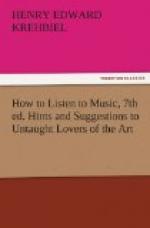[Sidenote: What a symphony is.]
[Sidenote: The bond of unity between the parts.]
The symphony then, as a rule, is a composition for orchestra made up of four parts, or movements, which are not only related to each other by a bond of sympathy established by the keys chosen but also by their emotional contents. Without this higher bond the unity of the work would be merely mechanical, like the unity accomplished by sameness of key in the old-fashioned suite. (See Chapter VI.) The bond of key-relationship, though no longer so obvious as once it was, is yet readily discovered by a musician; the spiritual bond is more elusive, and presents itself for recognition to the imagination and the feelings of the listener. Nevertheless, it is an element in every truly great symphony, and I have already indicated how it may sometimes become patent to the ear alone, so it be intelligently employed, and enjoy the co-operation of memory.
[Sidenote: The first movement.]
[Sidenote: Exposition of subjects.]
[Sidenote: Repetition of the first subdivision.]
It is the first movement of a symphony which embodies the structural scheme called the “sonata form.” It has a triple division, and Mr. Edward Dannreuther has aptly defined it as “the triune symmetry of exposition, illustration, and repetition.” In the first division the composer introduces the melodies which he has chosen to be the thematic material of the movement, and to fix the character of the entire work; he presents it for identification. The themes are two, and their exposition generally exemplifies the principle of key-relationship, which was the basis of my analysis of a simple folk tune in Chapter II. In the case of the best symphonists the principal and second subjects disclose a contrast, not violent but yet distinct, in mood or character. If the first is rhythmically energetic and assertive—masculine, let me say—the second will be more sedate, more gentle in utterance—feminine. After the two subjects have been introduced along with some subsidiary phrases and passages which the composer uses to bind them together and modulate from one key into another, the entire division is repeated. That is the rule, but it is now as often “honored in the breach” as in the observance, some conductors not even hesitating to ignore the repeat marks in Beethoven’s scores.




